Sugar is one of the most dangerous ingredients on the market. It’s addictive, added to almost every processed food, and will make you overweight, depressed and sick if you eat too much. In fact, Americans eat close to 130 pounds of the stuff per person per year (4 times more than the recommended daily allowance), likely because it is so addictive. That’s why it’s exciting to know there are alternative sweeteners made in nature, like “stevia,” that don’t wreak havoc on your health – or do they? Is Stevia safe? That’s what I went on a quest to find out. Here’s what happened…
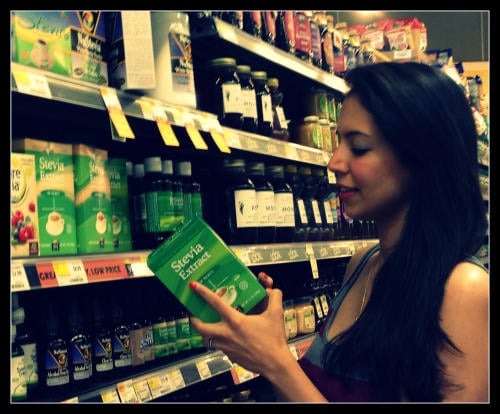
What Is Stevia?

For those of you that are hearing about stevia for the first time, it is a plant that is typically grown in South America, and while its extract is 200 times sweeter than sugar, it does not raise blood insulin levels. That’s what makes it so popular. However in 1991 the FDA refused to approve this substance for use due to pressure from makers of artificial sweeteners like Sweet n’ Low and Equal (a one billion dollar industry). But in 2008, the FDA approved the use of rebaudioside compounds that were derived from the stevia plant by Coca-Cola (Cargill) and PepsiCo – hmmm doesn’t that sound suspicious? Not until a major food company got involved did stevia become legal, and only after it had been highly processed using a patentable chemical-laden process…so processed that Truvia (Coca-Cola’s branded product) goes through about 40 steps to process the extract from the leaf, relying on chemicals like acetone, methanol, ethanol, acetonitrile, and isopropanol. Some of these chemicals are known carcinogens (substances that cause cancer), and none of those ingredients sound like real food, do they?
The whole leaf stevia that you can grow in your backyard (and has been used for centuries in countries like Brazil and Paraguay) remains a non-approved food additive by the FDA. However, rebaudioside A (the stevia extract) that was approved by the FDA has not been used for centuries and long term human health impacts have not been studied and are still unknown. The sweetener/sugar industry wields powerful influence over what is ultimately approved at the FDA, and this is just another example where they are influencing decisions that don’t make sense. How can a chemically derived extract be deemed safe in processed food and a plant from mother nature not?
What Kind Of Stevia To Avoid
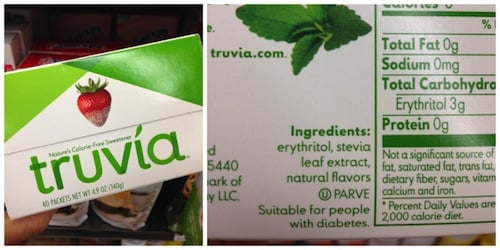
The 40-step patented process used to make Truvia should make you want to steer clear of this stevia product alone, but there are two other concerning ingredients added (not only to Truvia but other stevia products as well). First, erythritol is a naturally occurring sugar that is sometimes found in fruit, but food manufacturers don’t actually use the natural stuff. Instead they start with genetically engineered corn and then go through a complex fermentation process to come up with chemically pure erythritol. Check out the manufacturing process below:
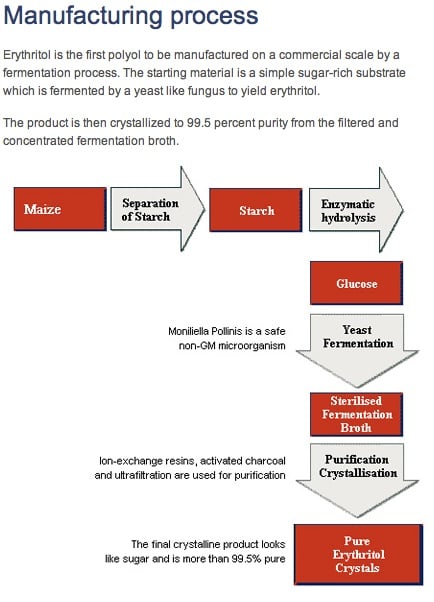
Credit: Cargill

“Natural flavors” is another ingredient added to powdered and liquid stevia products, likely due to the fact that once the stevia leaf is processed it can develop a metallic taste. Manufactured natural flavor is contributing to what David Kessler (former head of the FDA) calls a “food carnival” in your mouth. This makes it difficult to stop eating or drinking because the flavors they have synthesized will trick your mind into wanting more and more. When companies use manufactured flavor, they are literally “hijacking” your taste buds one-by-one; that’s why I recommend putting products that contain “natural flavors” back on the shelf.
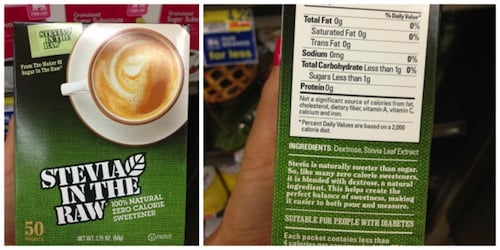
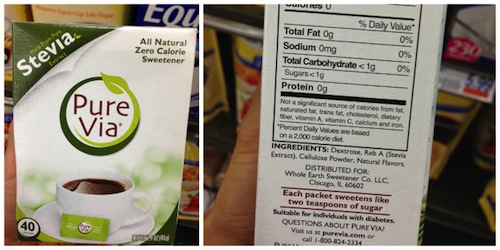
“Stevia in the Raw” sounds pure and natural, but when you look at the ingredients the first thing on the label is “dextrose” – so it’s certainly not just stevia in the raw. And Pepsi Co’s “Pure Via,” also pictured above, isn’t exactly pure either with this ingredient being first on the label, too. Dextrose is a sweetener that’s also derived from genetically engineered corn and has a long complicated manufacturing process, just like erythritol.
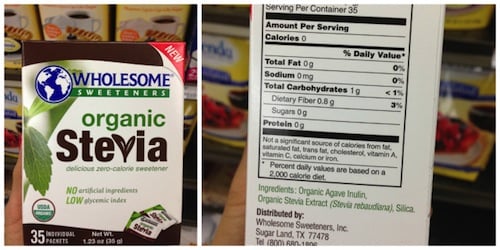

Even certified organic stevia can have sneaky ingredients added, like this one above which has more organic agave inulin than the stevia extract itself. Agave inulin is a highly processed fiber derivative from the blue agave plant. Also on the ingredient list is an item you are probably familiar with from those little packets sometimes found in boxed goods – silica (pictured). It is added to improve the flow of powdery substances and is the same ingredient that helps strengthen concrete and creates glass bottles and windowpanes. It may cause irritation of the digestive tract (if eaten) and irritation of the respiratory tract (if accidentally inhaled). While it is non-toxic and probably won’t kill you in small quantities, it’s definitely not a real food ingredient I would cook with or that I want to be putting in my body.
How To Choose The Right Kind Of Stevia
Luckily there are ways to enjoy this sweet leaf closer to it’s natural state… because let’s be honest, the no-calorie artificial sweeteners out there are really dreadful, and no one should consume them (check this post for the low down on those). So here’s what you can do:
- Buy a stevia plant for your garden (luckily it’s totally legal!) or purchase the pure dried leaves online – you can grind up them up using a spice grinder (or use a mortar and pestle) for your own powdered stevia.
- When choosing products already sweetened with stevia, look for “whole leaf stevia” on the ingredient label. For example one of my favorite protein powders is made with “whole stevia leaf” instead of rebaudioside a or stevia extract.
- Add fresh or dried leaves directly to tea or drinks for natural sweetness (note the straight stevia leaves are only 30-40 times sweeter than sugar, vs. 200 times using the extract).
- Make your own liquid stevia extract (see graphic below for recipe).

- If you are not up for getting a stevia plant of your own or making your own extract, remember to look for a stevia extract that is 100% pure without added ingredients (Sweet Leaf & Trader Joe’s have versions).
And when all else fails, choose a suitable alternative and forget stevia altogether. Use honey, pure maple syrup, or I personally prefer coconut palm sugar, since it is low glycemic (making it more diabetic friendly) and one of the most natural unprocessed forms of sugar available. It is naturally high in amino acids – has 10,000 times more potassium, 20 times more magnesium and 20 times more iron than conventional sugar. I use it all the time in my baking, from pound cake to muffins to a recent delicious cookie that is low in sugar – check out all those recipes here!
If you know someone who uses artificial sweeteners or stevia, please share this post with them.
Wishing you the best health life has to offer,
Food Babe



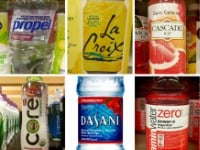
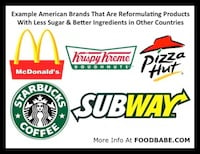



Thank you for doing this research. I had been wondering. Not sure I’ll go back to using any sort of sugar/sweetener after what I’ve been through in the past year though.
Hope you had a great weekend at the beach!
Thanks Janet. It was great – I didn’t do that much work 🙂 Next time the weather needs to be warmer!
Thanks for this! I have been using xylitol lately. I am curious what your thoughts are on this sweetener.
Are you stupid?! Does that even sound natural to you?
Really? What was the “stupid” comment about? That really wasn’t nice or necessary.
Wow! Thought this was a place to get some information – not be called names. Won’t be commenting again on this blog. And FYI xylitol is completely natural despite its name and it doesn’t raise blood sugar levels. Just google and see. I simply wanted to know others experience with it.
Apparently xylitol was a very common ingrediant found in chewing gum while my husband was living in Japan. Neither of us know what it is though! He is interested to know more since he noticed it in the Jason brand of toothpaste.
Hi Amanda-check out this great post about gum.
https://foodbabe.com/2011/12/09/wanna-a-piece-of-gum/
Tricia, don’t let ignorant/negative influence/ or drive you away from a GREAT site with loads of information.
Balls, needs to learn communication skills because s/he is showing his/her ignorance and maturity level.
As Joyce said, “That really wasn’t nice or necessary, Balls.”
Thank you for taking the time to write that
Tricia, you shouldn’t allow another person’s impolite response stop you from seeking information or interacting on this blog. I had a wise professor that once noted that there are no stupid questions in life – just stupid responses. 🙂 I imagine that name calling doesn’t reflect the blog owner’s manner of interaction or most other visitors. Be at peace and keep seeking to improve your health. Life is too short.
i don’t think its worth having you all getting upset. The person with the rude reply goes by the name of Balls.. im pretty sure his comment was meant to get a rise out of you all and he did just that
BIRCH xylitol is natural and safe – and delicious. No after tast like stevia…..
How rude! That remark is just a mirror of your intelligence.
I remember looking into Xylitol about a year ago. Pretty sure it is derived from corn, and therefore, if not labeled otherwise, it is probably GMO. Here is one description and since corn is ‘king’ in food processing, you can pretty well be assured that commercial xylitol is not made from birch. Check out this website for description. For other foods and supplements you eat just websearch for that item along with the word origin, or ingredient, or how made. If all else fails contact the company via the contact info on the label, and ask.. does this product contain GMO’s (or whatever you are interested in). One that surprised me was nutritional yeast. Most of it is cultured on beet sugar, and since beet sugar is largely from GMO sugar beets, well…. There are non-GMO brands, but you have to be diligent in finding them. Kal puts out a great non-GMO nutritional yeast. Hope this has been helpful. http://www.wisegeek.com/what-is-xylitol.htm
Very helpful … Thank you!
Well said. It IS made from GMO corn unless you buy an organic brand.
Xylitol is toxic. Here’s a report on xylitol.
http://www.scribd.com/doc/143107104/Birch-Xylitol-Report
Is this accurate?!
We’ve been using it for years.
Xylitol prevents cavities and kills bacteria in the mouth, gums, throat, and can even prevent ear infections if used on a daily basis. Spry makes toothpaste and gum which are available at whole foods and many organic product stores. It tastes very good in coffee and tea as well, you can bake with it. The benefits are my family hasn’t been sick in years! Since Fluoride is a neurotoxin, please seek SPRY as an alternative to trust plus! Peace
From what I understand xylitol is a class of sweetener known as a sugar alcohol. Sugar alcohols can be found in natural sources like many fruits and vegetables. For example the sugar alcohol known as erythritol can be found in grapes. Many makers of stevia-based sweeteners add a sugar alcohol to make it flow similar to sugar. Sugar alcohols (which end in the “-ol” suffix), unlike sugars (which end in an “-ose” suffix), metabolize independently of insulin so sugar alcohols don’t cause an insulin response which is why they’re considered “sugar free” sweeteners despite being somewhat similar to sugar in terms of texture. their only other difference form sugar is that sugar alcohols don’t brown/caramelize. As I said these sugar alcohols can be found naturally but very likely the sugar alcohols used in blends with stevia-based sweeteners were synthesized in a lab. Sugar alcohols metabolize in your intestinal tract so you have to be careful how much sugar alcohol you consume as it can cause some GI upset and many people have reported a laxative effect from overconsumption.
Hi Food babe
Any thoughts on the Rapunzel sugar, it shows 11% iron
http://www.iherb.com/Rapunzel-Organic-Whole-Cane-Sugar-24-oz-680-g/30369
I fell for this a few years back. I realized it was crap and threw out my Truvia.
…. I love when people throw out junk… but even better, I love when people take it back to the store and say they want their money back guarantee 🙂
Vani,
You are starting to wander into the ‘unknown!’ Just because Stevia is a ‘natural’ plant does NOT mean that it is NECESSARILY safe to EAT! The NATURAL nicotene in Tobacco IS a CARCINOGEN! Have you never heard of an ancient Greek philosopher who was FORCED to eat an entirely NATURAL plant, in ORDER to KILL him?
That’s EXACTLY what I’m going to do with my Stevia in the Raw. I’m going to get my money back!!! =D
Thank you so much for posting this information. I have been using Truvia recently thinking it was a safer and smarter choice, now I know better.
Thank you for this clear article. I bought Truvia thinking it was a good option to sugar. I kept it in the cabinet, unsure, until now. Now I’ll toss it!
I’m just wondering… I have seeds I got this year to grow the plant itself. Is it safe to use the leaft to sweeten tea? that’s the reason I got it for. In case of an emergency and as a sugar replacement.
Hi Maritza – Vani gives some great tips in the post about how to use the leaves if you grow your own.
After realizing how bad aspartame was I switched to what I thought were some more natural sweetners like stevia. Now that I’ve read this I don’t know what to do. Is there anything you would recommend? I’ve given up soda and decided to stick to tea, but I just need something to sweeten it up a little bit. I mainly drink water but for the times I want a little taste I turn to tea. Any suggestions on something that is safe?
Did you check out my tips at the end of the post? Here it is:
How To Choose The Right Kind Of Stevia
Luckily there are ways to enjoy this sweet leaf closer to it’s natural state… because let’s be honest, the no-calorie artificial sweeteners out there are really dreadful, and no one should consume them (check this post for the low down on those). So here’s what you can do:
1. Buy a stevia plant for your garden (luckily it’s totally legal!) or purchase the pure dried leaves online – you can grind up them up using a spice grinder (or use a mortar and pestle) for your own powdered stevia.
2. When choosing products already sweetened with stevia, look for “whole leaf stevia” on the ingredient label. For example my favorite protein powder is made with “whole stevia leaf” instead of rebaudioside a or stevia extract.
3. Add fresh or dried leaves directly to tea or drinks for natural sweetness (note the straight stevia leaves are only 30-40 times sweeter than sugar, vs. 200 times using the extract).
4. Make your own liquid stevia extract (see graphic below for recipe).
If you are not up for getting a stevia plant of your own or making your own extract, remember to look for a stevia extract that is 100% pure without added ingredients (Trader Joe’s has a version in a small bottle).
5. And when all else fails, choose a suitable alternative and forget stevia altogether. Lisa uses honey and pure maple syrup, and I personally prefer coconut palm sugar, since it is low glycemic (making it more diabetic friendly) and one of the most natural unprocessed forms of sugar available. It is naturally high in amino acids – has 10,000 times more potassium, 20 times more magnesium and 20 times more iron than conventional sugar. I use it all the time in my baking, from pound cake to muffins to a recent delicious cookie that is low in sugar – check out all those recipes here!
Can you comment on pure stevia extract concentrate from NuNaturals?
Thank you.
The stevia extract powder contains maltodextrin which is likely genetically modified.
https://foodbabe.com/possible-gmo-ingredients-a-z/
The vanilla liquid has natural flavors which you should avoid.
Sorry! Hope this helps.
“Natural flavors” is a catch all phrase used in ingredient lists so there is no reason anyone should avoid it unless you know what it is or cannot find out. I buy a product that uses that term in the ingredients and I called the company and asked what it is- turns out it’s rosemary extract. They are legally prevented from listing it out specifically in their ingredients- so don’t just assume you should avoid it until you know what it is… or unless you’re unable to determine that.
I’d also love to hear your thoughts on the NuNaturals brand. I have the alcohol free one. I don’t use it often but I’d still like some info on it since it doesn’t have that bad aftertaste most have.
See my reply to Monika above.
Hi Food Babe….I’m interested in trying Organic Coconut Palm Sugar. Is there any brand in particular you’d recommend? Thanks!
Hi Laura – Vani likes Nutiva and Big Tree Farms Brands – you can order on-line.
Thanks so much!!!
I see Big Tree Farms offers it in Blonde and Vanilla. Can you tell me what the difference is? I’m looking to replace white sugar in my coffee, and for baking too. Thanks!!
Laura – The blonde is the regular one and vanilla has a slight vanilla flavor. It is really a personal preference. You could use either one in baked goods and vanilla would be great in coffee if are a vanilla fan!
Just use the real stevia plant! It is so much cheaper, faster,nutricious and rewarding to walk into your garden break off a few leaves, dry them out, crush them and then place them in a sprinkle jar.
If you want *actualized* research on stevia: http://examine.com/supplements/Stevia/
What are you, a SCIENTIST?
Thanks for this, so many people don’t know that it’s a herb! I brought home some seeds and my husband was dumbfounded “you can grow sweetener….?”.
That said, I planted a few seeds and they aren’t growning, any special tips? There were only 15 in the pack so I want to be careful.
They are a bit finicky in Ky. I’ve had them grow large and lush one summer and die before maturing on other occasions. I plant, fertilize and water. That’s all. I don’t use pesticides. Mine have been planted in a southwest location from my house.
Here in Canary Islands we have a natural sweetener called “Miel de Palma” (“Palm Honey” or “Palm Syrup”). It’s a natural alternative to traditional sweetners and very similar to maple syrup but made from the sap of Canary Island Date Palm (Phoenix canariensis).
Palm Honey has a low glycemic index and can replace sweeteners such as Stevia, Agave, Sugar, Brown Sugar or Maple Syrup.
It has a low glycemic index because it’s super-high in fructose… higher than high fructose corn syrup– and as such as NOT a healthy sweetener.
So which type of sugar is best if we eat processed food?
Hey Vani! I made the switch to Stevia a few months ago, although I’ve known about it for probably 10+ years. The one I’m using I’ve been getting at Sprouts in the supplements section (NOT the sugar section with all the crappy ones), it is in liquid eye dropper form, and the ingredients as listed are:
Stevia Leaf Extract (Stevia rebaudiana) 300mg/ml
Vegetable Glycerin
Deionized Water
The serving size is 5 drops.
Is this stevia legit?
My nsi brand is that too so wondering the same thing.
Holly B.
If your Stevia lists vegetable glycerin I would recommend checking with the company that makes it. Unless it is certified organic, or non-GMO verified, the vast majority of vegetable glycerin is derived from corn. Hence, it is probably GMO.
I add a few Stevia leaves in my salads! Tastes amazing!
Oh! Great idea… I want to try that.
Stevia has been legal in the US for decades- the limit was in labeling it as a SWEETENER. It used to be listed as an ingredient in herbal teas all the time. I used to buy stevia powder in the supplement aisle at Whole Foods LONG before Truvia came out… and I’m still loyal to the NuNaturals brand.
Can you please check out nuts.com’s site regarding the Stevia they sell and tell me what you think.
http://www.nuts.com/cookingbaking/powders/stevia.html
I’d appreciate it. I just purchased the Palm sugar you use in your cookie recipe, but I was looking at this and wondering if any of the things you wrote about on your stevia blog applies to this Stevia product? The ingredients say Stevia, nothing else, and the site also says: The stevia is produced using a 100% water extraction method. It contains 90% stevicoids and it contains no additives,processing aids, carriers, or other sweeteners. It is non-GMO.
Let me know what you think please.
Hey dumbass xylitol can give u aids
Can you tell me if Sweet Leaf Stevia is a good brand?
Thanks
I also use SweetLeaf, so i am anxious for a reply.
thanks
I’m also wondering the same thing. I use Sweetleaf in my breakfast foods such as coffee or grapefruit. Did someone reply to your comment?
It’s not a good brand. The raw stevia is from China.
See my post on Feb. 9, 2014.
I have recently been using coconut sugar. However, I just read a post this morning that the production of coconut sugar leaves the coconut tree unable to produce actual coconuts. Making most production of coconut sugar non-sustainable. Plan to switch back to sucanat. See the link. http://www.thefoodcoach.com.au/articles/?ArticleID=1410&NLID=527&UID=28,439. Do you have further info on this issue?
I read that too from a VERY good source, so not going there with the coconut sugar.
I’ve been using Now Foods Better Stevia extract that I ordered from iHerb. The ingredients list only Certified Organic Stevia Extract Powder (Stevia rebaudiana) (Leaf). I think this sounds pretty good and I recommend it. 🙂
It is apparent after reading the comment section that many people did not read the article carefully. Could you please recommend a BRAND of liquid and power whole leaf stevia that is not an extract. Also I can not get the link to your fav protein powder to work from the face book post.
Thank you in advance.
I use TJ’s organic stevia.. the “small bottle”.. but I also have the SwweLeaf whole leaf stevia concentrate… is that one ok?? There isn’t anything else in it, but purified water.. is this one safe?? Thank you for your time.
This blog sizzles and I recommend it to everyone! Time VERY well spent!!!
Thank you Vani the ‘Food Babe’ you are a star!
I’ve been on a nutritional cleansing program for a couple of months now. I was a sugar addict for my entire life. I was told that sweet leaf flavored drops are okay. Can you confirm this please. I saw other’s post about sweet leaf, but I saw no response as to whether it was okay or not. Thanks so much and thanks for your site! I refer to it everyday to help me on my journey!!!!
So SweetLeaf because it’s fiber and extract, isn’t good; even though it’s verified nonGMO?
What is your favorite protein powder? Your link will not work
Wow! thank you so much for this info!!
I have the “Wholesome sweetners, organic stevia” in my cupboard, thinking I was finally doing something right my myself and my children… urrgghhh!! so annoyed!
will throw it out no doubt… again, can’t thank you enough…
You’re awesome <3
Much love and respect!!
I use Kal Organic Stevia extract from the leaf and there is nothing else added. It doesn’t make me want to keep eating, it doesn’t taste metallic and there is nothing added to compromise its integrity.
Not all great about coconut palm sugar… http://www.tropicaltraditions.com/coconut_palm_sugar.htm?gclid=CIHf-IHtkroCFbE7Mgodp2UAAg
Almost scared to ask for risk of getting filleted but is organic agave okay in coffee? I use it every morning.
Agave is almost pure fructose so not good.
Great article. My family and friends are all of a sudden “Stevia lovers.” I have always had my reservations and your article just confirmed it. I am going to forward this one to my friends and family so that they can make a more informed decision.
It does NOT matter where Erythritol comes from because chemical identity is only what matters – if it is 99.5% purity, this means only 0.5% of other impurities. And those impurities cannot be GMO carriers such as proteins or DNA simply because they are very large molecules whereas Erythritol – a very small one, polar, highly hydrophilic and therefore can be easily purified by crystallization. Erythritol is not a concern at all.
What are your thoughts on Agave?
One other thing to keep in mind (I haven’t read everyone’s posts so I apologize if it’s already been said), stevia is in the ragweed family of plants. If you have a ragweed allergy there is a chance of having cross sensitivity. I can only tolerate a few drops of liquid stevia in tea before I break out in itchy hives. I think that’s a good reason to market some protein powders without sweetener period. Let the consumer decide. Hope this information helps.
Thank you so much! This post was so incredibly helpful, as I had thought the brand I was using was safe. I appreciate the research you do, then pass along to us.
Very grateful 🙂
When we use sweeteners, we only use raw honey or organic brown rice syrup and only in moderation. Plenty of natural fruit and small amounts of cocoa/dark chocolate should take care of any sugar cravings. Sugar cravings are usually an indication of another issue in your diet.
I am exhausted by all the sweetener news. I was so happy to discover Stevia finally which l looked good. Thank you for sharing this information!
Do you think just using sugar again is a good idea? I only use sweetener in my 2 cups of coffee in the morning. I am tired of trying out new sweeteners only to find out they are dangerous.
I have recently started using Xylitol as a sweetener. It has only an 11 glycemic index. And can be used just like sugar. Can Food Babe do an article on Xylitol?
I took your advice and stopped using Sweet Leaf stevia I have been buying for many years because of the Inulin soluble fiber listed as the only ingredient. I have had some problems with gas, and I suspected that maybe it was the stevia, because I am eating totally healthy other than that. (And I thought the stevia was healthy!) I bought some stevia leaves on your recommendation, and it is easy to put a few leaves in with my tea and strain. Really tastes sweet too. And my gas is better.
Thanks!!!!
So where do you get an organic stevia plant or seeds to grow your own?
I gave up sugar in 1997 (I was in 7th grade), & my Dr recommended Stevia to me since I was a kid at the time (& kids usually love sweets… though I actually never really did since they always made me sick). He said that it also killed candida. which is why he recommended it as well (& I was diagnosed with systemic candida). I purchased it at a health food store, in liquid form, where it was just “Stevia, water” on the ingredient list (you had to use it up quick or it went bad…). It tasted terrible I remember, more bitter then sweet in my opinion lol
Thanx for the low-down on stevia. I was using Truvia and thought I was doing good on my weight loss journey! Now I feel stupid.
By the way the link to your favorite protein powder is not working. Can you give me the name of it so I can look it up?
I’ve just discovered you and think you are so helpful!
I doubt there will be any response to this since I do not see responses for over a month, but just in case, and since there is no where to ask questions other than here…..what about “swerve” I have just heard of it and they claim to be a non-GMO product…I normally use the coconut palm sugar, date sugar, brown rice syrup, and honey…but this one is calorie free and would love to find out any thoughts on this product…My family and I try to “listen to the babe” when it comes to what we eat because we feel she is very careful about what she would eat lol
I really found your story (name referenced in a HuffPost article) fascinating. Looking at the website has been very informative and one other aspect is very clear.
Vani is – hot, hot, hot!
Just wanted to mention that Xylitol is highly toxic, lethal even, to dogs. http://www.vcahospitals.com/main/pet-health-information/article/animal-health/xylitol-toxicity-in-dogs/4340